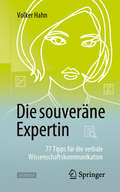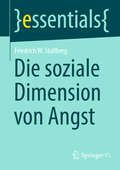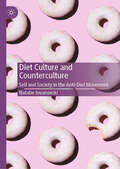- Table View
- List View
Die neue Kunst der Gesellschaft: Kunst im Netzwerk der Praktiken
by Stefan LüddemannDas Buch „Die neue Kunst der Gesellschaft“ entwirft eine neue kultursoziologische Beschreibung der Gegenwartskunst. Anders als in den Standardwerken von Pierre Bourdieu und Niklas Luhmann soll die Kunstszene nicht als Feld oder System, sondern als Formation aus Praktiken verstanden werden. Die Analyse stützt sich auf Denkformen der Praxissoziologie. Sie nimmt auf diese Weise erstmals in adäquater Weise die Expansion der Kunstwelt in den Blick. Beispiele liefern unter anderem die Documenta und die Skulptur Projekte Münster.
Die neue Macht der Konsumenten: Aus Ökonomischer, Soziologischer, Psychologischer Und Philosophischer Sicht
by Jan RommerskirchenDie Konsumenten haben ihre neue Macht entdeckt. Trends und Techniken wie Digitalisierung und Individualisierung, Moralisierung und Politisierung, Blogs und Tweets, Boykott und Buykott haben die Konsumenten in den letzten Jahren ermächtigt. Sie wollen nicht nur an der Ladenkasse still entscheiden, welche Produkte und welche Unternehmen akzeptabel sind, sondern Prozesse und Märkte aktiv mitgestalten und dadurch an einer besseren Welt mitarbeiten. Die zunehmenden Interaktionen zwischen Konsumenten und Unternehmen fordern von allen Beteiligten immer mehr Engagement für die gute Sache – einige sind davon aber auch überfordert und die Gefahren der wechselseitigen Manipulationen wachsen. Dieses Buch untersucht die neue Macht der Konsumenten aus verschiedenen Perspektiven: Wissenschaftler und Praktiker, Ökonomen, Soziologen, Psychologen und Philosophen beleuchten und hinterfragen die aktuellen Entwicklungen und Phänomene, Chancen und Risiken der neuen Macht der Konsumenten.
Die psychische Gewalt der Ignoranzfalle: Selbstcoaching Und Prävention Für Betroffene (Essentials)
by Lilo EndrissLilo Endriss vermittelt in diesem essential, wie verborgene Mechanismen ignoranter Verhaltensweisen durchschaut werden können und wie man sich durch Selbstcoaching dagegen wehrt. Denn subtile seelische Gewalt in Form von ignoranten Verhaltensweisen kann den Menschen genau wie körperliche Gewalt tief verletzen. Menschen sind auf Resonanz angewiesen, wie dies etwa durch die Entdeckung der Spiegelneuronen erforscht wurde. Wer ausgegrenzt, ständig übersehen oder überhört wird, erlebt dies als Kränkung. Diese besondere Form des Mobbings, die sowohl im Berufs- als auch im Privatleben stattfindet, kann nur durchbrochen werden, wenn sich Betroffene aus der Täter-Opfer-Verwicklung befreien.
Die revolutionäre Kraft der Ideen: Gesellschaftliche Grundwerte zwischen Interessen und Macht, Recht und Moral
by Max Haller„Werte“ sind ein beliebtes Thema von politischen Sonntagsreden und sie dienen politischen Institutionen und ihren Vertretern immer wieder dazu, sich nach außen gut darzustellen und problematische Aktionen (wie Kriege) zu legitimieren. Die Reaktion der Sozialwissenschaften ist vielfaches Naserümpfen und kritische Distanz zu Wertedebatten.Dieser Band geht dagegen aus von der Weberschen These, dass Ideen und Werte historisch ebenso starke Kräfte sein können wie ökonomische Interessen und politisches Machtstreben. Im Gegensatz zu umfangreichen sozial- und rechtsphilosophischen Werken, die sich vielfach in einer Endlosschleife ohne definitive Lösungen verheddern, wird in diesem Band jedoch argumentiert, dass die Thematisierung und Durchsetzung von gesellschaftlichen Grundwerten nur als Resultat der Auseinandersetzungen zwischen kritischen neuen Ideen, sozialen Bewegungen und Kämpfen, die von der Bevölkerung unterstützt werden, und politischen Reformen und Innovationen verstanden werden kann. Es zeigt sich, dass man in langfristiger historischer Perspektive tatsächlich von einer zunehmenden Durchsetzung der (neun) gesellschaftlichen Grundwerte ausgehen kann. Diese verläuft allerdings keineswegs bruchlos und linear, sondern ist durch vielfache zeitliche Verwerfungen, Verzögerungen und Rückschritte gekennzeichnet.Dieser Band markiert einen entscheidenden theoretischen Durchbruch in einer vielumstrittenen und bislang vielfach inkonklusiven Debatte. Er ist dazu auch deshalb in der Lage, weil er auf einem stringenten theoretischen Ansatz aufbaut, welcher der empirischen Werteforschung vielfach fehlt. Dabei bezieht er einen breiten Fundus an Literatur aus allen einschlägigen Geistes- und Sozialwissenschaften ein, von Theologie, Philosophie und Rechtswissenschaften über Ökonomie und Soziologie bis hin zur Psychologie.
Die sizilianische Mafia: Der bewaffnete Arm der Politik
by Anita BestlerEinen völlig neuen Zugang zu dem komplexen sozialen Phänomen Mafia bietet dieses Buch: Neben Ursprung, Organisation und Vorgehen der Mafia untersucht die Autorin Anita Bestler vor allem die enge Verbindung zwischen der organisierten Kriminalität und der Politik. Dabei erhalten die Leser*innen [außerdem] sowohl einen interessanten Einblick in die komplizierte politische Entwicklung Italiens von der Staatsgründung bis zur Gegenwart als auch eine Antwort, warum die Italiener politisch anders »ticken«.
Die sizilianische Mafia: Der bewaffnete Arm der Politik
by Anita BestlerEinen völlig neuen Zugang zu dem komplexen sozialen Phänomen Mafia bietet dieses Buch, das für die 2. Auflage grundlegend aktualisiert wurde: Neben Ursprung, Organisation und Vorgehen der Mafia untersucht die Autorin Anita Bestler vor allem die enge Verbindung zwischen der organisierten Kriminalität und der Politik. Dabei erhalten die Leser*innen sowohl einen interessanten Einblick in die komplizierte politische Entwicklung Italiens von der Staatsgründung bis zur Gegenwart als auch eine Antwort, warum die Italiener politisch anders »ticken«.
Die souveräne Expertin – 77 Tipps für die verbale Wissenschaftskommunikation
by Volker HahnNicht zu kommunizieren ist nicht möglich, und gut zu kommunizieren ist nicht einfach. Fachexpertise allein reicht jedenfalls nicht aus, um verständlich zu erklären, souverän vorzutragen und erfolgreich in den Medien aufzutreten. Dabei bergen wissenschaftliche Themen ganz spezifische Herausforderungen. Verbale Wissenschaftskommunikation ist eine Querschnittsaufgabe aus den Bereichen Strategie, Formulieren (Erklären und Erzählen), Rhetorik und Körpersprache. Für alle diese Bereiche vermittelt das Buch praktische Tipps mit zahlreichen Beispielen aus der Praxis. Es hilft Ihnen, zur „souveränen Expertin“ oder zum souveränen Experten zu werden – in (Medien-)Interviews, in Vorträgen, Gesprächen und Diskussionsrunden. 77 kurze und voneinander unabhängige Tipps machen das Buch ideal für die Lektüre zwischendurch.
Die soziale Dimension von Angst (essentials)
by Friedrich W. StallbergAngst ist ein Phänomen, welches fortwährend und allerorten in zwischenmenschlichen Beziehungen erzeugt und bearbeitet wird.Sie ist ungleich verbreitet und verteilt, unterliegt als Kommunikationsgegenstand kulturellen Prägungen und ruft sozial folgenreiche Schädigungen hervor. Dieses essential bietet eine kurzgefasste Erkundung der sozialen Natur der Angst. Mit dieser wird eine Soziologie der Angst angeregt, die nicht nur untersucht, wie Angst entsteht und sich wandelt, sondern auch aufdeckt und problematisiert, wann und wie soziale Verhältnisse unnötige und leidvolle Angst fördern und wann und wie ein produktiver Umgang mit Angst verhindert wird.
Die soziale Seite an Wirtschaft und Wissenschaft: Eine Kritische Betrachtung Zweier Spezialsoziologien
by Barbara KuchlerDass auch Wirtschaft und Wissenschaft „sozial“ sind, ist der Ausgangspunkt wirtschaftssoziologischer und wissenschaftssoziologischer Forschung. Doch was heißt eigentlich „sozial“? Wie ist dieser Begriff zu bestimmen und damit das eigene Erkenntnisinteresse abzustecken? Wirtschaftssoziologen und Wissenschaftssoziologen lassen sich hier gern von der Frontstellung zu Ökonomik und Epistemologie leiten, denen die Soziologie etwas entgegensetzen soll. Barbara Kuchler zeigt, auf welche Lieblingsbegriffe das führt – wie Macht, Netzwerk, Einbettung – und welche blinden Flecken damit einhergehen. Sie liefert eine grundlegende Reflexion und theoretische Kritik dieser Spezialsoziologien.
Die soziale Situation jugendlicher "Sinti und Roma"
by Therese TrauscheinDas Buch behandelt die (Aus-)bildungs-, Wohnungs-, Freizeit- sowie Familiensituation von dauerhaft in Deutschland lebenden ,,Sinti und Roma"-Kindern und -Jugendlichen. Neben der theoretischen Auseinandersetzung wurden qualitative Interviews mit ,,Sinti und Roma" im Alter von 12 bis 21 Jahren geführt. Die weitgehend vorurteilsgeprägte gesellschaftliche Wahrnehmung von ,,Sinti und Roma" soll mit deren Lebensrealitäten kontrastiert werden. Es gilt insbesondere pädagogisch Tätige zur Reflexion der eigenen Haltung gegenüber dem Thema anzuregen. Notwendig erscheint auch eine generelle Neubetrachtung von ,,Ethnizität" und ,,Kultur", zwei Begriffen, denen nicht nur innerhalb der Debatte um ,,Sinti und Roma" ein besonderer Stellenwert zugesprochen wird.
Die unsichtbaren Folgen des Extraktivismus: Ein Blick hinter die slow violence der chilenischen Bergbauindustrie (Energiepolitik und Klimaschutz. Energy Policy and Climate Protection)
by Anna LandherrDieses Open-Access-Buch beschäftigt sich mit Umweltproblemen, die selbst im Kontext der heutigen globalen ökologischen Krise weitgehend gesellschaftlich unsichtbar bleiben, da sie ihre oftmals schwerwiegenden sozial-ökologischen Auswirkungen allmählich, schleichend und über längere Zeiträume hinweg in Form einer slow violence (Rob Nixon) entfalten. Am Beispiel der toxischen Industrieabfälle (Tailings) der chilenischen Bergbauindustrie werden in der Untersuchung anhand von drei Fallstudien die zentralen Gründe und Dimensionen dieser Unsichtbarkeit dargestellt und ihr Zusammenspiel analysiert.
Die urbanen Wurzeln der Mafia: Mafiose Akteure und Strukturen im Sizilien des 16. und 17. Jahrhunderts (Interkulturelle Studien)
by Roberto LlaryoraAusgehend von Roberto Llaryoras Fallstudien und seiner Kritik an dem in den Medien und der Wissenschaft vorherrschenden, historisch und ethnographisch verkürzten Mafiabild geht das Buch folgenden Fragen nach:Erstens: Was verbirgt sich eigentlich hinter dem mafiosen Dispositiv, hinter der offenbar sehr eindeutig stadtgesellschaftlich eingebetteten Form gewaltsamer Machtausübung, was macht seine “DNA” aus? Zweitens: Welchen gesellschaftlichen Konstruktionselementen verdankt sich dieses ungewöhnlich flexible und dauerhafte Dispositiv? Drittens: Warum ist das bis in die Öffentlichkeit hinein gepflegte deutlich nostalgisch-kulturalistisch geprägte Mafiabild so resilient gegen jeden Versuch, einen sachadäquaten Zugang zu gewinnen?
Die verdrängte Realität: Hunger in der Überflussgesellschaft (essentials)
by Sabine PfeifferDeutschland ist ein Land mit zunehmender sozialer Ungleichheit. Hunger und Ernährungsarmut aber gelten in der öffentlichen und wissenschaftlichen Wahrnehmung kaum als Phänomen bundesdeutscher Wirklichkeit. Dieser Beitrag widerspricht dieser Sichtweise und zeigt anhand empirischer Annäherungen: Es gibt Hunger und Ernährungsarmut mitten in unserer vermeintlichen Überflussgesellschaft. Es finden sich kaum Studien, die das mit harten Daten belegen, aber es gibt - und es ist ein Ziel dieses Beitrags, dies zu zeigen - ernst zu nehmende Zahlen und Fakten, die nahe legen: Es gibt Menschen in unserem Land, die sich ohne Unterstützung nicht ausreichend ernähren können. Es geht dabei um das ,,Wieviel", aber auch um die Frage des ,,Was". Nicht das Gleiche essen zu können wie andere, das ist in einer pluralisierten und individualisierten Konsumgesellschaft auch eine Frage von Teilhabe. Alimentäre Teilhabe - das zeigt der zweite Teil dieses Beitrags am Beispiel des Essengehens - ist ein sozial-existenzieller Zugang zu Gesellschaft, der immer mehr Menschen verwehrt ist. Tafeln sind eine Antwort auf die wachsende Ernährungsarmut in unserer Gesellschaft. An ihnen zeigt sich aber auch, wie Politik und Gesellschaft auf dieses brisanter werdende Problem bislang reagieren: es wird delegiert, negiert und die Betroffenen werden stigmatisiert. Diese Strategien - so die abschließende These - tragen bei zu einer weiteren Verstärkung von Ernährungsarmut in Deutschland.
Die zwölf Grundannahmen der Netzwerkforschung
by Christian StegbauerDas Buch bietet eine Orientierung im Feld der Netzwerkforschung anhand des Dutzends wichtigster Annahmen, die dieses Forschungsfeld prägen. Dabei wird aufgezeigt, warum Beziehungsstrukturen und -stärken von Bedeutung sind. Die Struktur von Beziehungen wird als entscheidend für Verhaltensmuster und kulturelle Entwicklungen betrachtet. Das Konzept der "Kognitiven Sozialstruktur" wird eingeführt, um zu erklären, wie unser Verhalten von unserem Wissen über soziale Netzwerke abhängt.
Die österreichische Gesellschaft während der Corona-Pandemie: Ergebnisse aus sozialwissenschaftlichen Umfragen
by Wolfgang Aschauer Dimitri Prandner Christoph GlatzIn diesem Buch untersuchen Soziolog*innen und Umfrageforscher*innen erstmals systematisch in zehn fundierten Beiträgen die gesellschaftlichen Auswirkungen der Corona-Krise in Österreich. Datengrundlage des Sammelbandes, dessen Beiträge frei zum Download zur Verfügung stehen, sind mehrere Umfrageprojekte, die teils in mehreren Erhebungswellen über die Krisenzeit durchgeführt haben. Die Beiträge im Buch fokussieren primär auf die Zeit des ersten Lockdowns in Österreich und diskutieren – basierend auf den empirischen Befunden – die Folgen der Corona-Krise auf verschiedene Bereiche des Lebens.
Die „Gränze“ des Unterrichts: Deutungen des Universitätsseminars zwischen Idee und Empirie (Rekonstruktive Bildungsforschung #48)
by Helen LehndorfDas Buch beschreibt das geisteswissenschaftliche Universitätsseminar als eine besondere Form der unterrichtlichen Ordnung, welche sich in ihren Wertgrundlagen, institutionellen Rahmenbedingungen und Interaktionspraktiken von anderen Unterrichtsordnungen unterscheidet. Es werden unterschiedliche Einschätzungen zum Status des Universitätsseminars als unterrichtliche Ordnung auf Basis bisheriger theoretischer und empirischer Arbeiten nachgezeichnet. Auf diesem Weg wird die Grundlage für eine Rekonstruktion fachlicher Lehr-Lern-Interaktionen im literaturwissenschaftlichen Universitätsseminar gelegt. Dazu wird eine theoretische Deutung des Universitätsseminars als Sozialisationsraum vorgenommen und mit bislang erfolgten empirischen Beschreibungen von Lehr-Lern-Interaktionen im Rahmen der Universität konfrontiert. Besonderes Augenmerk liegt auf der methodischen Reflexion der jeweiligen Bestimmungen des Universitätsseminars und insbesondere auf der Frage nach dem Verhältnis von „Idee“ und „Empirie“.
Die „Unsichtbaren“ im Schatten der Gesellschaft - Forschungen zur Wohnungs- und Obdachlosigkeit am Beispiel Dortmund
by Dierk Borstel Tim Sonnenberg Stephanie SzczepanekObdachlosigkeit ist einer der schlimmsten persönlichen Schicksalsschläge in unserer Wohlstandsgesellschaft, und es gibt sie in jeder Stadt. Als Gegenstand sozialwissenschaftlicher Forschung ist Obdachlosigkeit aber dennoch unentdeckt. Die vorliegende Studie nähert sich dem Phänomen theoretisch wie empirisch.
Diego Maradona: A Socio-Cultural Study (Critical Research in Football)
by Pablo Brescia Mariano PazThis is the first book in English to closely examine the life of Diego Maradona from socio-cultural perspectives, exploring how his status as an icon, a popular sporting hero, and a political figurehead has been culturally constructed, reproduced, and manipulated. The volume looks at representations of Maradona across a wide variety of media, including literature, cinema, popular music, printed and online press, and radio, and in different countries around the world, to cast new light on topics such as the instrumentality of sporting heroes and the links among sport, nationalism, and ideology. It shows how the life of Maradona – from his origins in the barrio through to his rise to god-like status in Naples and as a postcolonial symbol of courage and resistance against imperial powers across the global south, alongside scandal and his fall from grace – powerfully illustrates themes such as the dynamics of gender, justice, and affect that underpin the study of sport, culture, and society. This is essential reading for anybody with an interest in football, sport studies, media studies, cultural studies, or sociology.
Diesseits und jenseits der Ökonomie: Kurzsichtige Krisenverwaltung oder weitsichtiger Neuanfang
by E. W. KüppersWeltwirtschaftskrisen sind immer auch Gesellschaftskrisen! Treibende ökonomische Kräfte verfolgen als »homo oeconomicus« rücksichtslos isoliert exzessive Wachstumsziele mit einem skurrilen Tanz ums »goldene BIP-Kalb« – auf Kosten aller anderen Gesellschaftsinteressen und unter Inkaufnahme massiver Umweltzerstörungen. Das Paradoxe dabei ist, dass sich die Ökonomie amüsanterweise als naturwissenschaftlich geprägt sieht, obwohl sie zutiefst den Sozialwissenschaften zuzurechnen ist. Der scheinbar unaufhaltsame Trend einer diesseitigen Ökonomie erfordert angesichts sich häufender sozialer und ökologischer Probleme einen einschneidenden Richtungswechsel. Dieser kann nur darin bestehen, dass eine jenseitige Ökonomie die Interessen aller Gesellschaftsteinehmer, im engen Verbund mit dem Erhalt unserer natürlichen Lebensgrundlage stärkt und fördert. Während eine diesseitige (mono)kausale Ökonomie konfliktträchtige Ziele verfolgt, ist eine jenseitige Ökonomie geprägt durch eine vorausschauende systemische Perspektive nachhaltiger gesellschaftlicher Weiterentwicklung.
Diet Culture and Counterculture: Self and Society in the Anti-Diet Movement
by Natalie JovanovskiThis book is the first of its kind to explore how women challenge the powerful sociocultural and gendered phenomenon of diet culture across the broad anti-diet movement and beyond. Showcasing the voices of over 150 everyday women, activists, and health professionals across Australia, New Zealand, Canada, the United States and the United Kingdom, the author provides new insight into anti-diet practices while giving agency for women who remain main targets of diet culture. Using Pierre Bourdieu’s concept of habitus as a novel starting point to develop a concept of the diet habitus, the author explores the possibility of a fragmented but unified diet counterculture. Drawing on feminist perspectives from women’s and fat liberation movements, the author demonstrates that women’s anti-diet practices are grounded in a combination of self and society; one that has the power to significantly re-shape the broad landscape of food and eating for women. This international book appeals to scholars, students, activists and health professionals interested in the intersections of the sociology of the body, fat studies, sociology of food and nutrition, social movements, health sociology, and women's studies.
Dieting, Overweight and Obesity: Self-Regulation in a Food-Rich Environment
by Wolfgang StroebeWhy do so many people become overweight and obese and why do they find it so difficult to lose weight? In this second edition of his influential book on Dieting, Overweight and Obesity, Wolfgang Stroebe – who developed the goal conflict model of eating – explores the physiological, environmental and psychological influence on weight gain and examines how these processes are affected by genetic factors. Like the first edition, the book takes a social-cognitive approach to weight regulation and discusses how exposure to environmental cues can set-off overeating in chronic dieters. In addition to extensively revising and updating the chapters of the first edition, this second edition features three new chapters. The chapter on successful restrained eating reviews personality factors as well as recent experimental research on impulse control. The chapters on psychological treatment of obesity and on primary prevention describe and evaluate the various treatment and prevention approaches and the research conducted to assess their efficacy. This book is essential reading for students, researchers and clinicians interested in an up-to-date review of the field of eating research and a new theoretical approach to the study of overweight and obesity.
Diez razones para borrar tus redes sociales de inmediato
by Jaron LanierUn brillante manifiesto que llama a la acción para comenzar a reinventar Internet. ¿Te cuesta imaginar una vida sin redes sociales? ¿Y si te dieran 10 argumentos explicando la toxicidad de sus efectos? En este libro, Jaron Lanier nos explica con una contundencia abrumadora como las redes sociales, al desplegar una vigilancia constante y manipular el inconsciente de sus usuarios, nos están convirtiendo en personas rencorosas, tristes, asustadizas, poco empáticas, aisladas y triviales. Si quieres una vida más feliz, un mundo más justo y pacífico, o simplemente la oportunidad de pensar por ti mismo sin ser monitoreado e influenciado por las corporaciones más ricas de la historia, lo mejor que puedes hacer es cancelar tus cuentas. Ahora. Reseñas:«Jaron Lanier es un genio.»Sunday Times «Mezcla sabiduría profética con una simple practicidad. Lectura esencial.»The New York Times «El título lo dice todo... Lanier aboga por desanclarse de las redes sociales, que fomentan la adicción y la anomia y en general nos hacen sentir peor y más temerosos el uno del otro y del mundo. El experimento podría ser útil, aunque oscurecerá los corazones de los señores oscuros, un argumento ganador por sí mismo.»Kirkus Reviews
Difference In View: Women And Modernism (Gender And Society Ser.)
by Gabriele GriffinThis collection of essays challenges conceptions of "high" modernism, its preoccupation with style at the expense of issues such as race, class and gender, and its exclusive focus both on predominately male writers, poetry and prose fiction by highlighting the diversity of cultural production in the modernist period. This book focusses specifically on women's cultural production, covering a wide range of arts and genres including chapters on painting, theatre, and magazines. The book investigates how women usually constructed as "others", themselves construct others in their work in a period prominently concerned with the construction of self as an issue. This diversity offers a new format of reading modernism in a cross-disciplinary context.
Difference Matters: Communicating Social Identity (Second Edition)
by Brenda J. AllenAllen's proven ability and flare for presenting complex and oftentimes sensitive topics in nonthreatening ways carry over in the latest edition of Difference Matters. Her down-to-earth analysis of six social identity categories reveals how communication establishes and enacts identity and power dynamics. She provides historical overviews to show how perceptions of gender, race, social class, sexuality, ability, and age have varied throughout time and place. Allen clearly explains pertinent theoretical perspectives and illustrates those and other discussions with real-life experiences (many of which are her own). She also offers practical guidance for how to communicate difference more humanely. While many examples are from organizational contexts, readers from a wide range of backgrounds can relate to them and appreciate their relevance. The second edition includes updated statistics, recent research, and examples from contemporary events in the United States.
Difference and Modernity: Social Theory and Contemporary Japanese Society (Routledge Library Editions: Japan)
by John ClammerThe question of ‘postmodernity’ that has swept Western academic and intellectual circles raises critical comparative questions. Do societies that have not experienced the same historical development as the West pass inevitably through modernity into postmodernity, or can they skip such stages altogether? Japan, the only non-Western society to develop independently a fully-fledged capitalist-industrialist economy, poses such fundamental questions to social theory. Is Japan in fact ‘unique’ and as such is it a society which escapes the net of conventional sociological abstractions? The book questions how special Japanese society really is, the limitations of Western social theory in grasping the fullness of this dynamic and a complex Asian society, and inquires as to how Japan in turn may speak to social theory and deepen and broaden the principles on which social theory attempts to explore and categorize the social and cultural worlds.
























